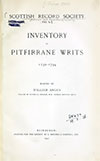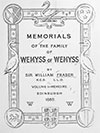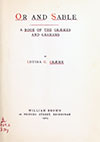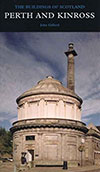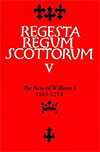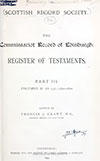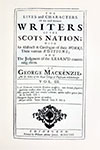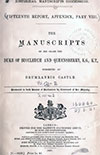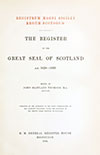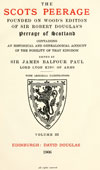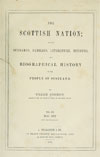

Glendoick House is a mid-18th century mansion but it incorporates the remains of an earlier tower house.
The lands of Glendoick are first mentioned in the early 13th century when Geoffrey, son of Richard of Inverkunglas, and later John, son of Richard of Invertiel, give 20 shillings from their land of Glendoick to the abbey of Coupar Angus. These two Richards may be one and the same making Geoffrey and John brothers. Geoffrey de Inverkunglas died around 1230 and was succeeded by his son, Richard de Balwearie.
The surnames of these individuals are not recorded however a Michael Scott of Balwearie is on record from 1280. In 1484 James III confirmed a charter of the lands and barony of Glendovok, with its mill, to William Scott of Balwearie.
In 1503 Sir William Scott of Balwearie seems to have sold the lands and barony of Glendovok to William Hay, 3rd Earl of Erroll, who had a charter of the barony from James IV in the same year. In 1509 John Hay, probably the third son of the 3rd Earl, had a sasine of Glendovok and its mill however the property seems to have returned to the Scotts as in 1510 the lands of Glendowak were erected into a free barony by James IV for William Scott of Balwearie.
Later that year he disposed the same lands of Glendowok to John Ferguson of Downy in warrandice of the lands of Downy which included those of “Over Downy, Middill Downy Borldand, Edinarnochty, Cultolony, Stronymuk, Faynzeand, Inneridrie with the mill, Bynnanmor, Bynnan-beg, Randeevoyach, Kerauch, Cowthill and Dalmonge, cum partibus de Pitbrane Glengaisnet and Glenbeg.” This charter was witnessed by Patrick Buttar or Butter of Gormack, more of whose family later.
The manor and fortalice of Glendoick are mentioned in a charter of 1529 confirming William Scott as the heir of William Scott of Balwearie. Numerous properties in Fife and Perthshire are listed including the manor lands of Glendoick with the manor, fortalice, mill, gardens and orchard. The tower stood in an elevated position at the foot of the Sidlaw Hills, overlooking the wide expanse of the Carse of Gowrie and the River Tay beyond.
A charter of 1548 mentions the manor and fortalice of Glendoick when Mary, Queen of Scots, confirmed their transfer from Sir William Scott to his son of the same name. In 1569 the younger Sir William Scott of Balwearie wrote to John Wemyss of Wemyss asking him to be a cautioner or guarantor “for whatever sums the Bishop of Moray should recover by law against him of his teinds of Glendowok”. The aforementioned John Ferguson’s son, Robert, was married to Janet Wemyss, the daughter of David Wemyss of Wemyss who may have been the father of John Wemyss.
In 1579 there was a disposition and assignation of “the lands and baronies of Stramiglo, Glendook and others which belonged to the late Sir William Scot of Balwery” by Robert Colville of Cleisch, James Lyndesay of Dowhill and Alexander Monypenny of Kynkell to George Halket of Petfirran.
Two years later in 1581 William Ruthven, 4th Lord Ruthven, was created 1st Earl of Gowrie by the young James VI and later that year the King confirmed numerous privileges due to the Earl. These included, amongst many other things, “lie Kanequheit de Glendowok” or “the kane wheat of Gledoick”. However due to his involvement in the Raid of Ruthven, a plot to kidnap the King at Ruthven’s Huntingtower Castle, all his honours were forfeited and his lands distributed amongst the King’s favourites.
Glendoick seems to have been returned to the Scotts of Balwearie as in 1584 Janet Lindsay, Lady Balwearie, signed a contract with James Scott of Balwearie according to which she would renounce “her conjunct fee lands of Manes of Balverie and 5 chalders victual from lands of Glendoak” in exchange for James paying 12,000 merks to his brothers and sisters.
In 1595 Sir James Scott of Balwearie signed a contract with his cousin, William Scott of Abbotshall, to ensure that his “lands and baronies of Innerteill, Stramiglo, Glendock, Balwearie and others” would remain in the Scott family by passing to William’s son, James, should Sir James’s line fail.
Glendoick is marked on Pont’s late 16th century map as a castle named Glendowak.

Timothy Pont, c. 1583 – 96map image courtesy of NLS
In 1602 James VI confirmed Sir David Murray of Gospertie, Comptroller of Scotland, as the owner of the lands and manor of Glendovoke which James Scott of Balwearie had resigned. The barony of Ruthven and the lands of the abbacy of Scone were erected into the lordship of Scone for Murray in 1605.
James VI granted to Sir David, by then Lord Scone, various properties in Fife and Perthshire in 1612 including the demesne (manor) lands of “Glendook”, the mill and mill lands. However in 1617 Sir David sold the lands of Glendook, along with other Fife and Perthshire properties, to Peter Hay of Durdie with the consent of his elder brother, Andrew Murray of Arngask and Balvaird.
The Murrays may have retained the superiority of the properties however as following Sir David’s death without issue in 1631 Charles I confirmed the transfer of the lands to Andrew Murray of Balvaird, Sir David’s nephew.
In 1672 Charles II confirmed a charter transferring the lands and barony of Glendoick from David Murray, 1st Viscount of Stormont, to Thomas Murray, advocate, and his wife, Barbara Hepburn, daughter of Thomas Hepburn of Blackcastle, erecting them into a free barony with “the manor place of Glendoick to be the principal messuage of the said barony”. Murray was made a Lord of Session in 1674, a baronet in the Baronetage of Nova Scotia in 1676 and was appointed Lord Clerk Register in the same year, serving until at least 1681.
Sir Thomas was the son of Sir Robert Murray of Woodend and descended from the Murrays of Tullibardine and Ochtertyre. He died in 1684 or 1685 and was succeeded by his son Sir Thomas Murray of Glendoick, 2nd Bt., who bought Balmanno Castle from Sir Archibald Auchinleck.
Sir Thomas died in 1701 and was in turn succeeded by his brother, Sir John Hepburn-Murray of Glendoick, Blackcastle and Balmanno, who in 1703 married Mary Murray, daughter of Sir Patrick Murray of Ochtertyre. Sir John died in 1714 and was succeeded by his son, Sir Patrick Murray, 4th Bt.
In 1726 the advocate Robert Craigie bought Glendoick. According to Historic Environment Scotland he bought part of the estate “from the Butter family who had owned it since the 13th century” although I have not been able to find another reference to this and the ownership by the Scotts of Balwearie seems solid back to the 15th century and likely back to the 13th century. Interestingly Sir Thomas Murray, 2nd Bt., was involved in a court case against Buttar in 1696 although I haven’t been able to ascertain yet what this concerned.
In 1742 Craigie became Lord Advocate and the present house is thought to have been built for him between 1746 and 1748. The new house consisted of an exposed basement level plus two further storeys, harled white with sandstone dressings. The five bay south front has an advanced centre bay under a pediment and within the bay is a Venetian doorway with broken pediment reached by a flyover stair.
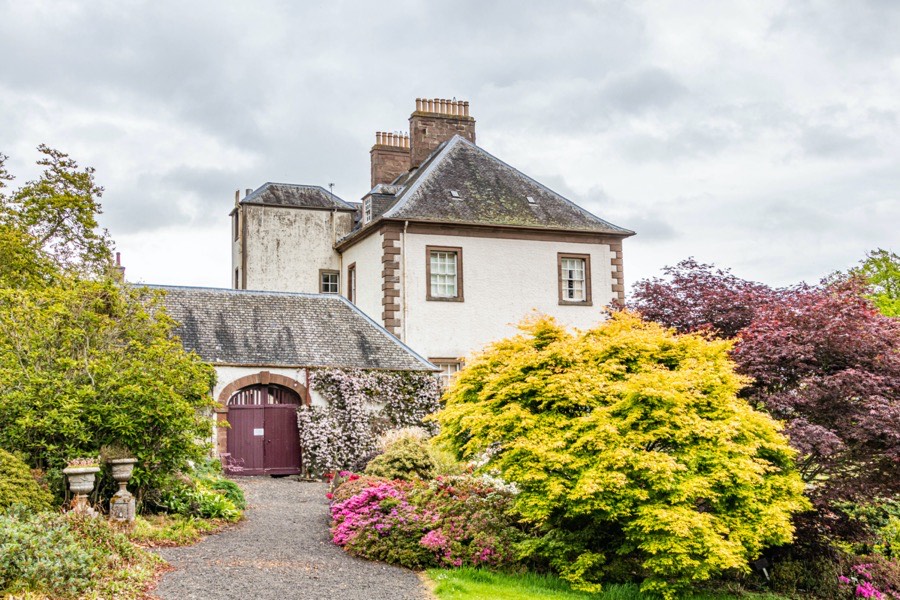
The steep peind roof has a slight bell cast and two tall panelled chimneystacks below which are dormer windows, thought to be a later addition. To the rear of the house is a projecting wing in the centre of the north façade which may be a remodelled remnant of the old tower house.
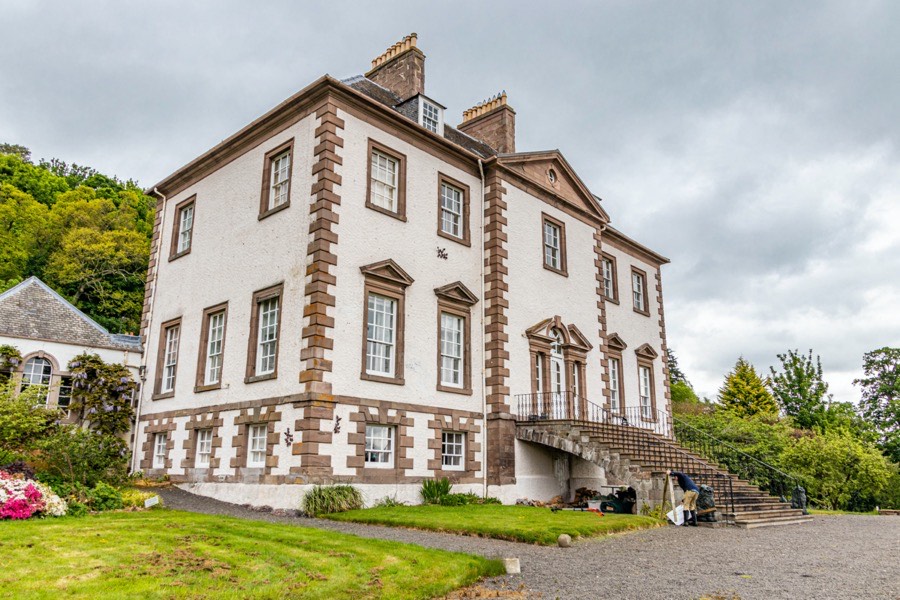
Behind the house is a courtyard range, the west wing of which is a single storey in height while the north and east wings were later raised to two storeys.
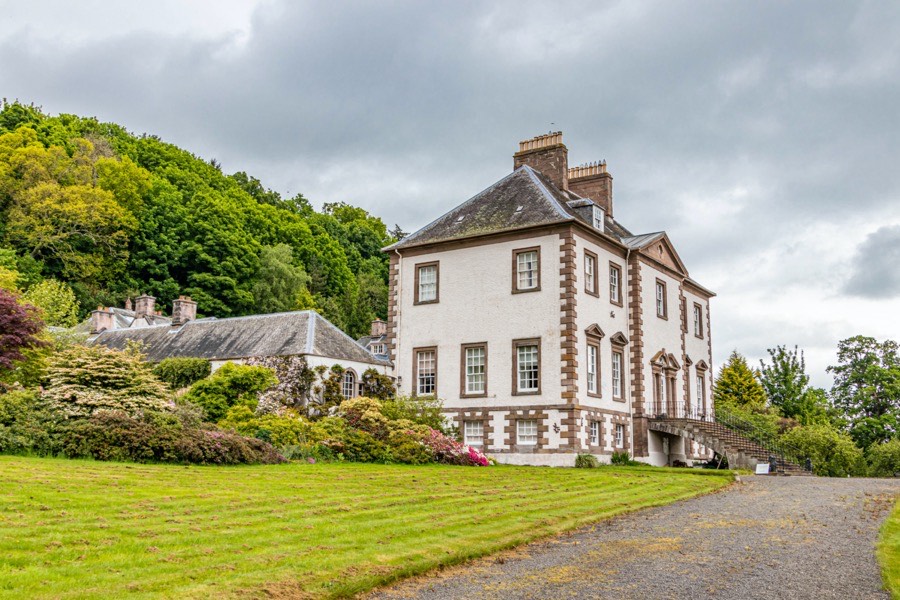
In 1754 Craigie was appointed Lord President of the Court of Session taking the judicial title Lord Glendoick. Meanwhile the Murray baronets were still designating themselves “of Glendoick”, the 4th baronet dying in 1756. Lord Glendoick died in 1760 but what became of Glendoick at this point is not entirely clear. It may have simply passed to his son, David. Again according to Historic Environment Scotland David bought “the bulk of the estate in 1773” possibly suggesting that the Craigies had only owned part of the estate until this time and that David added to the estate thirteen years after the death of his father.
The 4th baronet was succeeded by his son, Sir Alexander Murray, as 5th baronet. He was an officer in the Army and died without issue in America in 1774. He was succeeded by his sister, Mary, who seems to have inherited her brother’s estates in the same year. This event and David Craigie’s purchase of “the bulk of the estate” might be connected, perhaps signifying the unification of the old estate.
It’s possible that the Butter family had owned part of Glendoick separate from the part owned by the Scotts of Balwearie then the Murrays, but I haven’t found any references to this in historical documents. However it is also possible that charter of 1510 was misunderstood and thought to indicate Butter ownership of Glendoick.
I found a few references to a John Graham of Glendoick between 1704 and 1729 but there do appear to have been a couple of other properties named Glendoick, with variations of the spelling, so these may refer to a Glendoick elsewhere.
David Craigie was not Lord Glendoick’s eldest son however but the third son. The eldest, Charles, died in 1779 and was succeeded by the second son, John. During John’s ownership in 1790 the main road from Dundee to Perth, which used to run close to the house, was moved down onto the Carse of Gowrie and the policies below the house were laid out after this. John had died by 1805 and while a John Craigie, younger of Glendoick, was mentioned in 1802 it seems that the elder John was succeeded by his son, Laurence Craigie.
A Craigie married a descendent of Halkett of Pitfirrane and took the name Laurence Craigie-Halkett. A Laurence Craigie was in residence in 1857.
The Craigie family continued to reside at Glendoick until the late 19th century when it was leased to the jute baron Alfred Cox. The Cox family were heavily involved in the jute industry in Dundee with their company Cox Brothers operating from Camperdown Works in Dundee. In 1899 Alfred bought Glendoick and around 1910 the architect A.G. Heiton was commissioned to modernise the property and built a thatched lodge to the south-east (now slated).
In 1918 the heir to the jute business, Euan Cox, was working at the Foreign Office in London and met the horticultural writer and plant hunter Reginald Farrer at a tea party. He agreed to accompany Farrer on a plant collecting expedition to Burma the following year and upon his return he established a woodland garden at Glendoick. Although still based in London he developed the gardens on visits to Glendoick from 1921 onwards and eventually returned home full time in 1931 to help run the jute business.
Upon the death of Alfred in 1943 Euan moved to Glendoick with his family in 1944 and after the war he sold the jute business. In 1953 Euan and his son Peter founded Glendoick nursery which became renowned for rhododendrons in particular. Peter and his wife Patricia opened Glendoick Garden Centre in 1973, four years before Euan’s death in 1977.
Glendoick House and Glendoick Garden Centre are both still owned by the Cox family. The woodland gardens are open to the public during April and May.
Alternative names for Glendoick House
Glendavick; Glendoak; Glendock; Glendoeick; Glendoek; Glendoich; Glendoig; Glendoige; Glendoik; Glendoock; Glendook; Glendooke; Glendouk; Glendouok; Glendovok; Glendovoke; Glendowack; Glendowak; Glendowok; Glenduuoch; Glenduwok





